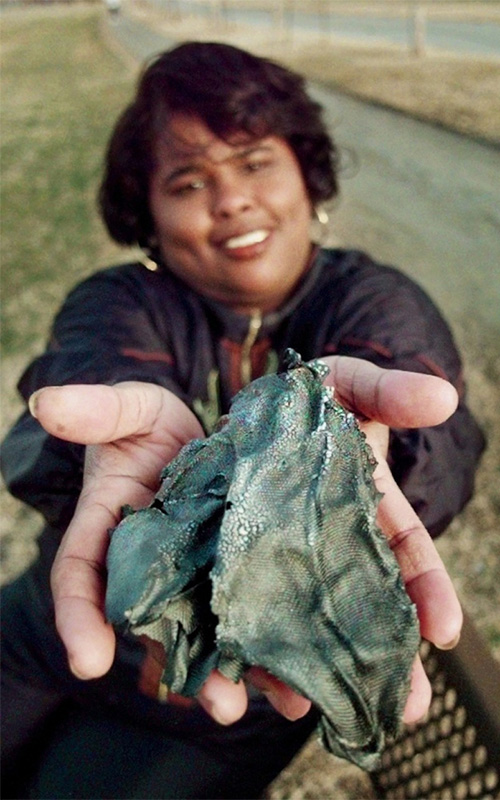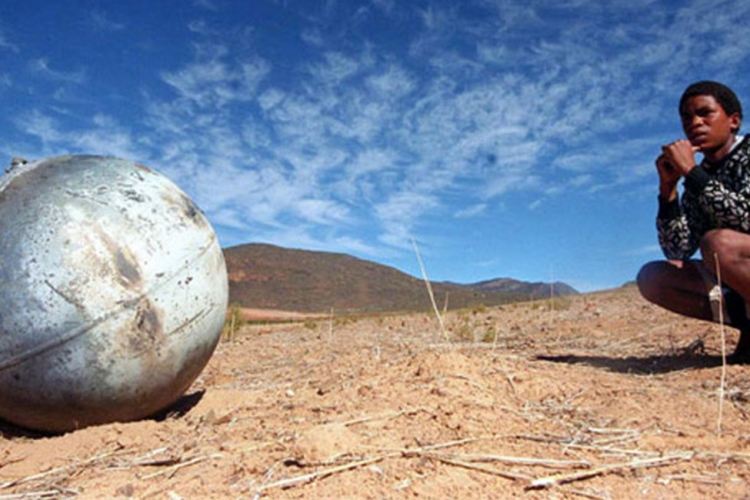On that fateful day in January 1997, Lottie was minding her own business strolling through the park, when—BAM—hit by a chunk of a Delta II rocket fuel tank. She wasn’t injured in the slightest. Arguably, one can be optimistic and say that Lottie was actually the luckiest person in the world to have survived a direct hit by space junk, as opposed to the unluckiest person in the world to have been hit by space junk.
Deliberations aside, let’s talk about …

Your chances of being hit by space junk
Your overall risk of being hit and injured by a piece of reentering debris is estimated to be less than one in one trillion.
Let’s break this down to further illustrate just how small this is: Your chances of winning Powerball are much higher—one in 292 million. Your chance of being hit by lightning in the U.S. is one in 1.4 million, and being killed in a hurricane is one in six million. Over the last 40 years, more than 5,400 metric tons of materials are predicted to have survived reentry—even over populated areas—with no reported casualties. The largest object to reenter was the Russian Space station, Mir, weighing 120,000 kg.
Preventing harm to life and property on Earth
For those old enough to remember, the 1979 reentry of the U.S. space station Skylab was rife with worldwide fanfare and some hysteria—it seemed everyone had some sort of “plan” to avoid the impending debris hit. But thanks to NASA controllers who fine-tuned the space station’s attitude (orientation) during its final orbits, Skylab reentered in an orbit that passed over as few populated areas as possible. Its debris eventually reentered on the southern Australian coast, and no one was hit.
NASA controlled Skylab’s debris footprint (ground area containing all its fallen debris) by performing a “deorbit maneuver.” If a satellite or rocket stage has propulsive capability, it can be commanded to execute one burn or a series of burns to lower its orbit so that the object will reenter at a specific location. For objects that pose a hazard to people and property on the ground, a deorbit maneuver is crucial, since this technique assures that the debris hits the ocean.
Another example is NASA’s controlled deorbit of the 14,000-kg Compton Gamma Ray Observatory (CGRO) into the south Pacific Ocean. More than 35 percent of CGRO’s mass was anticipated to survive reentry, and the falling debris would have been profoundly damaging to humans and property. On June 4, 2000, NASA deorbited CGRO with four thruster burns, safely landing its debris in the Pacific Ocean.
This begs the question …
Can you make an exact debris landing prediction?
You can’t—not with pinpoint precision, that is. Since predicting where debris will land is extremely difficult, analysts can only predict to some extent the location of the debris footprint to indicate the general area the debris will land.
A one-minute error in predicting the reentry time changes the debris’ location by nearly 300 miles. The surviving pieces of the object will be spread over a long footprint, so that two nearly identical fragments may impact many miles apart. For instance, four components on the Delta stages left debris in Texas and South Africa!
The main difficulty in predicting footprint location relates to uncertainties in forecasting the object’s lifetime in orbit. Still, given sufficient tracking of the object during the orbit decay, combined with measurements of solar activity over extended time, it’s possible to obtain a fairly good approximation of the date and time (but not location) of an object’s final reentry.
There is a ±20 percent uncertainty of the time of the final reentry. Considering that orbiting objects are travelling at more than 7 km/sec, a prediction made at the beginning of the object’s last orbit could be off by as much as ±18 minutes, equivalent to more than 8,000 km on the ground. This means that the debris footprint could be located anywhere along this 8,000-km-long path!
Why satellites deorbit and fall to Earth
In orbit, objects are exposed to atmospheric drag, just like aircraft and cars are on Earth—except that in space, there is much less drag. Still, even a tiny amount of drag can cause a satellite to reenter into a denser atmosphere.
Upon reentering the atmosphere, a large debris object is subjected to extreme heating and loads caused by its interaction with the atmosphere—at the reentry point, the object is travelling more than 20 times faster than a bullet. The temperature of the object eventually reaches a critical point, aerodynamic loads increase, and the object breaks up. The first major breakup generally occurs at an altitude between 74 and 83 km. At this point, the object fractures into several smaller objects.
Approximately 10 to 40 percent of a satellite survives reentry; it just depends on the materials used in the object’s construction. For example, if the object consists of empty fuel tanks made of stainless steel or titanium, both of which have an extremely high melting point, much of the material will survive. If the structure is made of aluminum, which has a low melting point, a much smaller percentage will survive.
And just as air will slow a piece of paper more than it will a lead ball, a light piece of debris will slow rapidly and hit the ground at a slower speed than a heavier piece of debris. In general, impact velocities will range from about 30 km/hr for lightweight debris to 300 km/hr or more for heavier objects.

